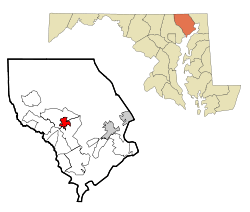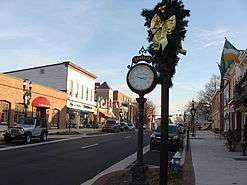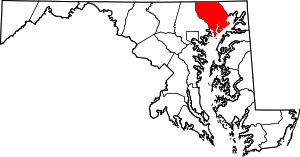Bel Air, Harford County, Maryland
| Bel Air, Harford County, Maryland | |
|---|---|
| Town | |
| Town of Bel Air | |
|
South Main Street | |
 Location of Bel Air, Maryland | |
| Coordinates: 39°32′12″N 76°20′54″W / 39.53667°N 76.34833°WCoordinates: 39°32′12″N 76°20′54″W / 39.53667°N 76.34833°W | |
| Country |
|
| State |
|
| County |
|
| Founded | 1780 |
| Incorporated | 1874 |
| Government | |
| • Type | Mayor-council |
| • Chairman of Board of Commissioners | Susan Burdette |
| Area[1] | |
| • Total | 3.03 sq mi (7.61 km2) |
| • Land | 3.02 sq mi (7.59 km2) |
| • Water | 0.01 sq mi (0.03 km2) |
| Population (2010)[2] | |
| • Total | 10,120 |
| • Estimate (2013[3]) | 10,307 |
| • Density | 3,453.9/sq mi (1,333.6/km2) |
| Time zone | Eastern (EST) (UTC-5) |
| • Summer (DST) | EDT (UTC-4) |
| ZIP codes | 21014, 21015 |
| Area code(s) | 410, 443, and 667 |
| FIPS code | 24-05825 |
| Website | Bel Air, Maryland |
The town of Bel Air is the county seat of Harford County, Maryland.[4] According to the 2010 United States Census the population of the town was 10,120.[5]
Geography
Bel Air is located at 39°32′12″N 76°20′54″W / 39.53667°N 76.34833°W (39.536707, -76.348280).[6]
According to the United States Census Bureau, the town has a total area of 3.03 square miles (7.85 km2), of which, 3.02 square miles (7.82 km2) is land and 0.01 square miles (0.03 km2) is water.[1]
Climate
Bel Air is a transition between the humid continental and humid subtropical climates. Bel Air features hot, often humid summers, mild, wet springs, pleasant falls and cool to cold winters. The average precipitation for Bel Air is around 40-43 inches while snowfall averages 19–24 inches.
Transportation
Bel Air is located on U.S. Route 1, and several miles north of Interstate 95. Route 1 has both a bypass around Bel Air and Hickory, and a business route snaking through downtown. Both are connected to I-95 by Maryland Route 24 (at Edgewood) and Maryland Route 543 (at Riverside).
In the mid 20th century the Maryland and Pennsylvania Railroad ("Ma and Pa") ran through town, but the tracks were dismantled in 1958. The station was located (at milepost 26.5) on Rockspring Ave. between Broadway and Ellendale St. Much of the railroad's former route in and around Bel Air is now the Ma and Pa walking trail, which cuts through various wooded sections of town in and around Heavenly Waters Park.
Government
Bel Air Police Department
Bel Air's primary law enforcement agency is the Bel Air Police Department which was established in 1874. Its headquarters is located at 39 N. Hickory Avenue.
Demographics
| Historical population | |||
|---|---|---|---|
| Census | Pop. | %± | |
| 1850 | 255 | — | |
| 1860 | 197 | −22.7% | |
| 1870 | 633 | 221.3% | |
| 1890 | 1,416 | — | |
| 1900 | 961 | −32.1% | |
| 1910 | 1,005 | 4.6% | |
| 1920 | 1,091 | 8.6% | |
| 1930 | 1,650 | 51.2% | |
| 1940 | 1,885 | 14.2% | |
| 1950 | 2,578 | 36.8% | |
| 1960 | 4,300 | 66.8% | |
| 1970 | 6,307 | 46.7% | |
| 1980 | 7,814 | 23.9% | |
| 1990 | 8,860 | 13.4% | |
| 2000 | 10,080 | 13.8% | |
| 2010 | 10,120 | 0.4% | |
| Est. 2015 | 10,190 | [7] | 0.7% |
2010 census
As of the census[2] of 2010, there were 10,120 people, 4,491 households, and 2,568 families residing in the town. The population density was 3,453.9 inhabitants per square mile (1,333.6/km2). There were 4,744 housing units at an average density of 1,619.1 per square mile (625.1/km2). The racial makeup of the town was 89.8% White, 4.4% African American, 0.2% Native American, 1.8% Asian, 0.1% Pacific Islander, 1.7% from other races, and 2.0% from two or more races. Hispanic or Latino of any race were 4.3% of the population.
There were 4,491 households of which 26.9% had children under the age of 18 living with them, 41.0% were married couples living together, 11.4% had a female householder with no husband present, 4.8% had a male householder with no wife present, and 42.8% were non-families. 36.3% of all households were made up of individuals and 15.4% had someone living alone who was 65 years of age or older. The average household size was 2.20 and the average family size was 2.89.
The median age in the town was 40.3 years. 20.5% of residents were under the age of 18; 8.9% were between the ages of 18 and 24; 26.1% were from 25 to 44; 26.1% were from 45 to 64; and 18.4% were 65 years of age or older. The gender makeup of the town was 47.8% male and 52.2% female.
2000 census
The census of 2000 reports that there were 10,080 people, 4,235 households, and 2,511 families residing in the town. The population density was 3,583.7 people per square mile (1,385.0/km²). There were 4,444 housing units at an average density of 1,580.0 per square mile (610.6/km²).
There were 4,235 households out of which 28.2% had children under the age of 18 living with them, 45.2% were married couples living together, 10.4% had a female householder with no husband present, and 40.7% were non-families. 35.2% of all households were made up of individuals and 14.8% had someone living alone who was 65 years of age or older. The average household size was 2.25 and the average family size was 2.94.
| White | 92.8% |
| African American | 4.4% |
| Asian | 1.4% |
| Native American | 0.2% |
| Pacific Islander | < 0.1% |
| Other | 0.3% |
| Two or more races | 0.9% |
| TOTAL | 100.0% |
| (Hispanic or Latino, any race | 1.2%) |
| Under 18 years | 22.1% | |
| 18-24 | 8.2% | |
| 25-44 | 30.5% | |
| 45-64 | 21.8% | |
| 65 or over | 17.4% |
The median age was 39 years.
| Age Group | Females | Males | |
|---|---|---|---|
| All ages | 51.5% | 48.5% | |
| 18 years or over | 52.3% | 47.7% |
| Per capita | $23,737 |
| Median household | $44,135 |
| Median family | $58,299 |
| Median male | $42,412 |
| Median female | $29,207 |
6.4% of the population and 4.0% of families were below the poverty line. Out of the individuals living in poverty, 7.6% were under the age of 18 and 6.5% were 65 or older.
History
Bel Air's identity has gone through several incarnations since 1780. Aquilla Scott, who had inherited land known as "Scott's Improvement Enlarged," planned the town on a portion that he called "Scott's Old Fields." Four years later, the town had expanded as local politicians, merchants, and innkeepers purchased lots from Scott, and the county commissioners decided to change its name to the more appealing "Belle Aire." In his deeds, Scott dropped one letter, renaming the town, "Bell Aire." Around 1798, court records dropped two more letters, and "Bel Air" was born.
During this period, Bel Air began to rise in prominence. In 1782, just two years after its founding, it became Harford's county seat, and Daniel Scott (Aquilla's son) started building a courthouse on Main Street. Although the town limits in the late 18th century encompassed nothing more than the two sides of Main Street, the days following the Civil War saw a building and land-development boom that remains in full swing to this day.
Originally known as "Scott's Old Fields" Bel Air was part of a land grant issued to Daniel Scott in 1731. In March 1782 "Belle Aire" was designated the county seat of Harford County. At the turn of the twentieth century the "e" was dropped and the second "l" and its companion "e" gave way a few years later. The town's incorporation was effective in 1874. The town began with just 42 lots along Main Street centering on the Court House and the county jail and sheriff's house. Over the years, the population grew slowly to about 200 residents by 1865. The introduction of the canning industry, the Ma & Pa railroad and related financial businesses jump started the growth after the Civil War. Although the town experienced periods of rapid growth followed by extremely slow growth over the next century, Bel Air's role as the center of government and commerce continued to expand.
Since 1980, the town and its surrounding suburbs have grown substantially. Today, Bel Air is the center for governmental, educational, cultural, medical, and commercial institutions in the county.
In the early 20th century, several fires swept through the downtown area, notably in 1900 and 1942. In 1972, another fire struck, decimating the east side of Main Street and causing $2 million in damage.
In 1970, H. Rap Brown, a member of the Black Panthers, was charged with instigating a riot after a rally in Cambridge; a change in venue brought his trial to Bel Air. In an attempt to assassinate Brown, radicals drove to Bel Air in a car laden with plastic explosives, intending to take down the courthouse. The car exploded prematurely, about a mile from the courthouse, and left a crater in the road. The trial was eventually moved again.
Into the 1950s, the town hosted horse racing at Bel Air Racetrack, which stood where the Harford Mall is today.
The Bel Air Armory, Bel Air Courthouse Historic District, Broom's Bloom, D. H. Springhouse, Dibb House, Graham-Crocker House, Graystone Lodge, Harford Furnace Historic District, Harford National Bank, Hays House, Hays-Heighe House, Heighe House, Joshua's Meadows, Liriodendron, Mount Adams, Norris-Stirling House, Odd Fellows Lodge, Priest Neal's Mass House and Mill Site, Proctor House, Thomas Run Church, Tudor Hall, The Vineyard, and Woodview are listed on the National Register of Historic Places.[9]
Notable people
- John Archer, United States representative and physician, recipient of first medical diploma issued in United States, from what is now University of Pennsylvania School of Medicine; 1741 – 1810
- Lisa Aukland, professional bodybuilder and powerlifter
- Edwin Thomas Booth, brother of John Wilkes Booth and son of Junius Brutus Booth; considered one of greatest Shakespearean actors of 1800s
- John Wilkes Booth, American stage actor and assassin of President Abraham Lincoln
- Augustus Bradford, 32nd Governor of Maryland, 1862 – 1866
- Cigar, champion racehorse
- Pat Healey, midfielder for Crystal Palace Baltimore and Baltimore Blast
- Julienne Irwin, America's Got Talent finalist, singer
- Chase Kalisz, swimmer, silver medalist at 2016 Summer Olympics
- Howard Atwood Kelly, pioneering gynecologist, one of "big four" founding staff members of Johns Hopkins University School of Medicine
- Kimmie Meissner, figure skating Olympian, 2006 World Champion and 2007 U.S. Champion
- Melvin Mora, former Baltimore Orioles player, lived in Bel Air
- Herman Stump, Congressman; U.S. Commissioner-General of Immigration under President Grover Cleveland
- Drew Westervelt, professional lacrosse player for Chesapeake Bayhawks and Colorado Mammoth
- Jay Witasick, MLB pitcher
Small airports
The three small plane airports in the metropolitan area are:
- Forest Hill Industrial Airpark
- Fallston Airport
- Harford County Airpark
References
- 1 2 "US Gazetteer files 2010". United States Census Bureau. Archived from the original on 2012-01-24. Retrieved 2013-01-25.
- 1 2 "American FactFinder". United States Census Bureau. Retrieved 2013-01-25.
- ↑ "Population Estimates". United States Census Bureau. Archived from the original on 2013-06-17. Retrieved 2013-06-26.
- ↑ "Find a County". National Association of Counties. Archived from the original on 2012-07-12. Retrieved 2011-06-07.
- ↑ http://www.city-data.com/city/Bel-Air-Maryland.html
- ↑ "US Gazetteer files: 2010, 2000, and 1990". United States Census Bureau. 2011-02-12. Retrieved 2011-04-23.
- ↑ "Annual Estimates of the Resident Population for Incorporated Places: April 1, 2010 to July 1, 2015". Retrieved July 2, 2016.
- ↑ "Census of Population and Housing". Census.gov. Archived from the original on May 11, 2015. Retrieved June 4, 2015.
- ↑ National Park Service (2010-07-09). "National Register Information System". National Register of Historic Places. National Park Service.
External links
- Official website of The Aegis
- Official website of Bel Air, Maryland
![]() Media related to Bel Air, Harford County, Maryland at Wikimedia Commons
Media related to Bel Air, Harford County, Maryland at Wikimedia Commons
 |
Bel Air North |
Forest Hill |
Dublin |
 |
| Fallston |
|
Churchville | ||
| ||||
| | ||||
| Kingsville |
Bel Air South |
Creswell |

